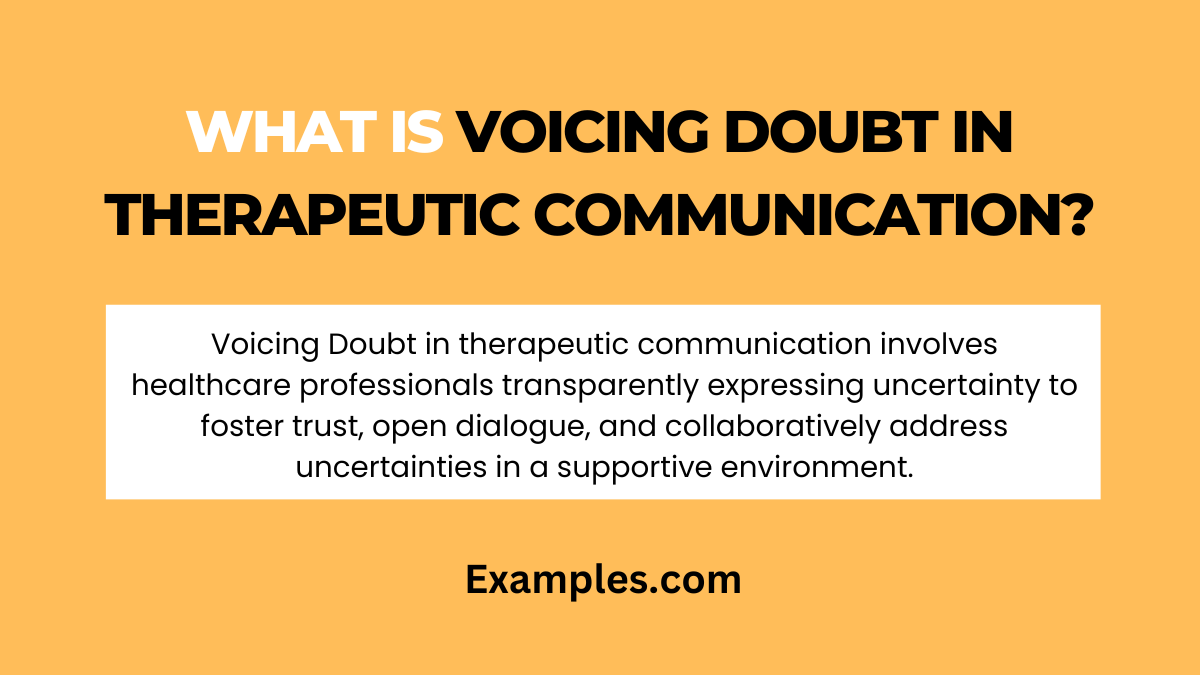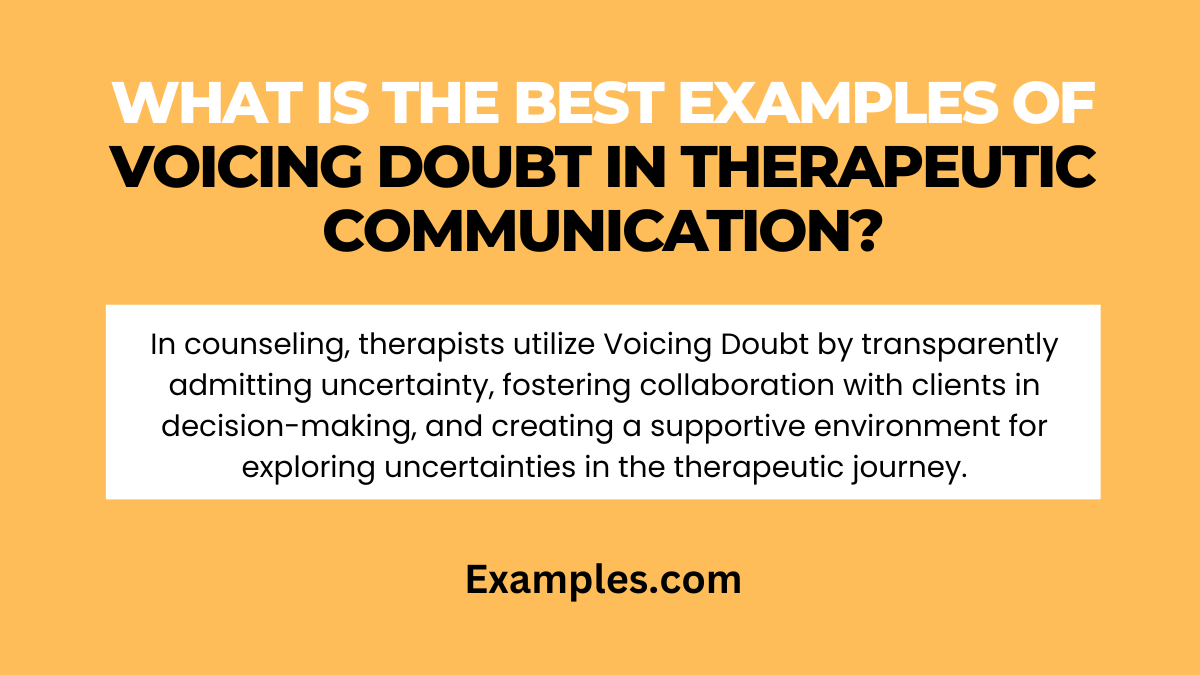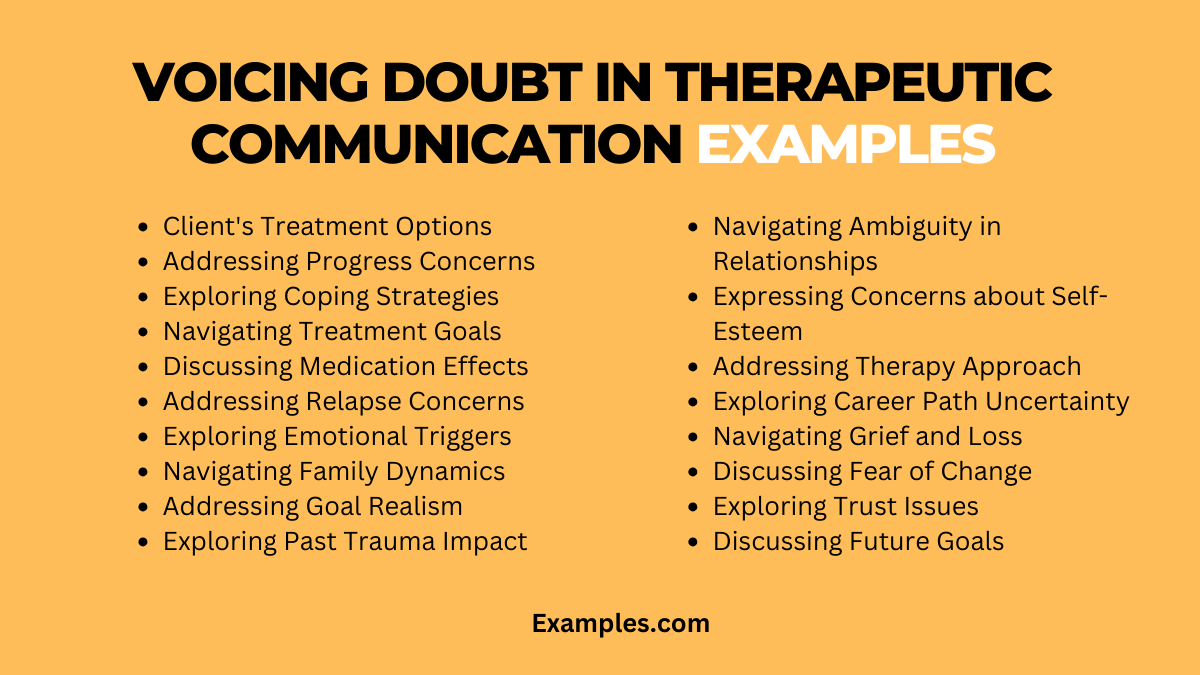19+ Voicing Doubt in Therapeutic Communication Examples
“Unlock the transformative potential of ‘Voicing Doubt’ in therapeutic communication with our comprehensive guide. Navigating uncertainties is an art, and this guide delves into effective strategies, real-life scenarios, and expert insights to skillfully express doubt with empathy and build trust. Explore illuminating ‘Communication Examples’ that illustrate the nuanced balance of fostering openness while maintaining therapeutic rapport. Elevate your communication skills for more meaningful and impactful interactions in the healing process.”
What is Voicing Doubt in Therapeutic Communication?

Voicing Doubt in therapeutic communication is a deliberate expression of uncertainty or hesitation by a healthcare professional. This technique involves transparently sharing doubts or concerns to foster trust, encourage open dialogue, and collaboratively address uncertainties within the therapeutic relationship. It is a nuanced approach aimed at navigating uncertainties with empathy and promoting a supportive environment for individuals under care.
What is the Best Example of Voicing Doubt in Therapeutic Communication?

In a counseling session, a therapist may employ Voicing Doubt by saying, “I’m uncertain about the best course of action, and I want to explore this together.” This transparent admission encourages the client’s active involvement in decision-making, fostering a collaborative therapeutic alliance. By acknowledging doubt, the therapist invites open discussion, promoting a shared exploration of uncertainties and empowering the client in their journey toward well-being.
20 Voicing Doubt in Therapeutic Communication Examples

Explore 20 nuanced examples showcasing the skillful use of Voicing Doubt in therapeutic communication. Each example is crafted to illustrate the delicate balance of expressing uncertainty while fostering a supportive and trusting environment.
- Client’s Treatment Options: “I’m uncertain about the ideal treatment. Let’s discuss the options and find what resonates with you.”
- Addressing Progress Concerns: “I’m unsure about your progress. Can we explore any challenges you might be facing?”
- Exploring Coping Strategies: “I’m uncertain which coping strategy suits you best. Let’s work together to discover effective methods.”
- Navigating Treatment Goals: “I have doubts about our current goals. How do you envision success, and what adjustments can we make?”
- Discussing Medication Effects: “I’m uncertain about the medication’s impact. Let’s discuss any changes you’ve noticed.”
- Addressing Relapse Concerns: “I have doubts about potential relapse. How can we strengthen your support system?”
- Exploring Emotional Triggers: “I’m uncertain about your emotional triggers. Can you share more about situations that provoke intense feelings?”
- Navigating Family Dynamics: “I have doubts about your family dynamics. How can we improve communication within your family?”
- Addressing Goal Realism: “I’m uncertain if our goals are realistic. Let’s revisit and adjust based on your current circumstances.”
- Exploring Past Trauma Impact: “I’m unsure about the impact of past trauma. Would you like to delve into those experiences?”
- Navigating Ambiguity in Relationships: “I have doubts about navigating relationship ambiguity. Let’s explore your feelings and expectations.”
- Expressing Concerns about Self-Esteem: “I’m uncertain about your self-esteem. Can we discuss factors influencing how you perceive yourself?”
- Addressing Therapy Approach: “I have doubts about our therapeutic approach. Let’s collaborate on a method that resonates with you.”
- Exploring Career Path Uncertainty: “I’m uncertain about your career path. Let’s explore your passions and aspirations.”
- Navigating Grief and Loss: “I have doubts about how you’re processing grief. Can we discuss your coping mechanisms?”
- Discussing Fear of Change: “I’m uncertain about your fear of change. Let’s explore strategies to navigate transitions together.”
- Addressing Body Image Concerns: “I have doubts about your body image struggles. How can we work towards a more positive perception?”
- Exploring Trust Issues: “I’m uncertain about the trust issues you mentioned. Can you share specific situations triggering these concerns?”
- Navigating Anxiety Management: “I have doubts about managing your anxiety. Let’s identify triggers and effective coping mechanisms.”
- Discussing Future Goals: “I’m uncertain about your future goals. Can we create a plan that aligns with your aspirations and values?”
Voicing Doubt in Therapeutic Communication for Clients Examples
Explore nuanced examples of Voicing Doubt tailored for clients, showcasing the skillful use of uncertainty expression in therapeutic communication. Each instance provides a supportive and trusting atmosphere while addressing various client-specific concerns.
- Client’s Future Decisions: “Expressing doubt about future decisions invites clients to actively participate in their choices, fostering empowerment.”
- Navigating Personal Boundaries: “Voicing doubt about boundary-setting encourages clients to reflect on their comfort levels, promoting self-awareness.”
- Expressing Treatment Progress Uncertainty: “Uncertainty about treatment progress sparks collaboration, ensuring clients actively engage in their healing journey.”
- Discussing Coping Strategy Effectiveness: “Doubt about coping strategy effectiveness invites clients to share insights, fostering adaptive and personalized approaches.”
- Navigating Relationship Dynamics: “Voicing doubt about relationship dynamics prompts clients to explore emotions, enhancing interpersonal awareness.”
- Expressing Concerns about Self-Efficacy: “Uncertainty about self-efficacy encourages clients to evaluate their capabilities, fostering confidence-building dialogues.”
- Discussing Goal Attainability: “Doubt regarding goal attainability invites clients to reassess and adapt, ensuring realistic and achievable therapeutic objectives.”
- Exploring Personal Growth Challenges: “Voicing doubt about personal growth challenges encourages clients to embrace vulnerability, promoting a growth-oriented mindset.”
- Expressing Uncertainty in Skill Development: “Uncertainty about skill development invites clients to reflect on their strengths, fostering a personalized approach to enhancement.”
- Navigating Ambiguity in Life Transitions: “Voicing doubt about life transitions prompts clients to share concerns, facilitating a collaborative exploration of uncertainties.”
Voicing Doubt in Therapeutic Communication in Counseling Examples
Discover impactful examples of Voicing Doubt tailored for counseling scenarios, illustrating the versatility of uncertainty expression in facilitating open and collaborative dialogues.
- Exploring Past Trauma Impact: “Expressing doubt about past trauma impact encourages open exploration, fostering trust and understanding in counseling relationships.”
- Addressing Present Anxiety Triggers: “Voicing doubt about present anxiety triggers prompts shared exploration, guiding counseling sessions toward effective anxiety management.”
- Expressing Concerns about Coping Strategies: “Uncertainty about coping strategy effectiveness in counseling invites clients to share personal insights, ensuring tailored and adaptive approaches.”
- Navigating Client’s Relationship Patterns: “Doubt about relationship patterns fosters insightful discussions, guiding counseling sessions toward building healthier connections.”
- Discussing Fear of Change:“Voicing doubt about a client’s fear of change prompts collaborative exploration, facilitating counseling discussions on embracing transitions.”
- Addressing Client’s Perceived Limitations: “Expressing uncertainty about perceived limitations encourages clients to reassess capabilities, fostering a positive self-perception in counseling.”
- Navigating Grief and Loss Processing: “Voicing doubt about grief and loss processing prompts shared exploration, guiding counseling discussions toward effective coping strategies.”
- Expressing Uncertainty in Self-Reflection: “Uncertainty in self-reflection encourages clients to embrace introspection, fostering deeper insights and self-awareness in counseling.”
- Discussing Present Mood Fluctuations: “Doubt about mood fluctuations prompts collaborative exploration, guiding counseling sessions toward understanding and managing emotional states.”
- Exploring Client’s Personal Values: “Voicing doubt about personal values invites clients to reflect on their beliefs, fostering alignment with authentic and meaningful goals in counseling.”
What are the techniques for Voicing Doubt in Therapeutic Communication?
In the realm of therapeutic communication, the technique of Voicing Doubt serves as a nuanced approach to navigate uncertainties, fostering trust, openness, and collaboration between healthcare professionals and clients. By transparently expressing uncertainty, this technique encourages clients to actively engage in discussions, share insights, and play an integral role in decision-making processes. This guide explores the intricacies of Voicing Doubt, offering techniques that enhance the therapeutic relationship and promote meaningful dialogue.
- Transparent Expression: Openly acknowledge uncertainties, demonstrating authenticity and vulnerability, which can empower clients to do the same.
- Empathetic Framing: Communicate doubt with empathy, ensuring clients feel supported and understood rather than overwhelmed by uncertainties.
- Collaborative Exploration: Engage clients in collaborative discussions to explore doubts together, fostering a shared understanding and empowering clients in decision-making.
- Reflective Inquiry: Utilize reflective questions to encourage clients to delve deeper into their thoughts, emotions, and concerns, guiding the exploration of uncertainties.
- Goal Reassessment: Work collaboratively with clients to reassess and adjust therapeutic goals based on their evolving needs and circumstances.
- Validation of Uncertainty: Validate clients’ uncertainties as natural and part of the therapeutic process, normalizing their feelings and fostering a non-judgmental environment.
- Active Listening: Employ active listening skills to grasp the nuances of clients’ uncertainties, ensuring a thorough understanding before offering guidance.
- Strengths-Based Approach: Highlight clients’ strengths and resilience while addressing doubts, emphasizing their capacity to overcome challenges and make informed decisions.
- Exploration of Client Values: Encourage clients to explore their values and beliefs when faced with uncertainties, aligning therapeutic approaches with their personal principles.
- Outcome Collaboration: Collaborate with clients to define potential outcomes, incorporating their input to shape realistic and achievable therapeutic objectives.
Tips for Effective Voicing doubt in Therapeutic Communication?
By incorporating these tips into the practice of Voicing Doubt, healthcare professionals can enhance the effectiveness of therapeutic communication, fostering a more meaningful and collaborative relationship with their clients.
- Cultivate Authenticity: Embrace genuine expression, allowing yourself to authentically convey doubts, fostering a transparent and trusting therapeutic relationship.
- Balance Empathy and Honesty: Strive for a delicate balance between expressing doubts with honesty and framing them with empathetic language to maintain a supportive atmosphere.
- Use Reflective Language: Employ reflective language to articulate uncertainties, inviting clients to explore their own thoughts and emotions in response.
- Encourage Client Participation: Actively involve clients in the process by encouraging them to share their perspectives on uncertainties, facilitating collaborative decision-making.
- Normalize Uncertainty: Normalize the experience of uncertainty, emphasizing that it’s a natural part of the therapeutic journey and an opportunity for growth.
- Practice Active Listening: Cultivate strong active listening skills to fully comprehend clients’ concerns, ensuring that doubts are addressed in a contextually sensitive manner.
- Foster a Non-Judgmental Environment: Create a safe and non-judgmental space where clients feel comfortable expressing their uncertainties without fear of criticism.
- Explore Underlying Emotions: Delve into the emotions underlying doubts, encouraging clients to articulate and process their feelings for a more comprehensive therapeutic experience.
- Align with Client Values: Tailor the exploration of doubts to align with clients’ values and beliefs, ensuring that therapeutic interventions resonate with their individual perspectives.
- Collaborate on Goal Setting: Collaboratively reassess and set goals based on the uncertainties discussed, empowering clients to actively participate in shaping their therapeutic journey.
In conclusion, mastering the art of Voicing Doubt in Therapeutic Communication empowers healthcare professionals to create an atmosphere of trust, collaboration, and understanding. By embracing transparency and employing nuanced techniques, this approach cultivates meaningful dialogue, fostering clients’ active engagement in decision-making. The comprehensive guide, enriched with examples, provides a roadmap for navigating uncertainties, promoting genuine connections and positive therapeutic outcomes.



